QuestionQUESTION: Last week I inherited a Bearded Dragon. It is about 5 years old. It is about 2 feet long and has been living in the same cage all it's life. I assume it was without food for about 3 weeks. I was told that the previous owned would not give it live food and the only thing it ate was romaine and canned worms of some kind. I brought it home and gave it some small crickets and small meal worms, just a few every day for about 4 days. Today I gave it larger meal worms and tried large crickets. It does now want the crickets at all but loves the meal worms.
I gave it a both today, which it hated. It shut it's little eyes and tolerated the bath.
I will not eat greens at all.
Should I keep feeding it mealworms? It's really cute and I like it. I want to do what is best for it now and I am confused because of it's past.
It seems to be very alert and healthy.
Thanks
Cindy
ANSWER: Hi Cindy,
I'm going to include a basic care sheet that I wrote to help people out with beardie care.
At his age, his diet should consist of about 90% greens and only 10% insects. Romaine is not a green of choice. Try offering collard greens, turnip greens, arugula, dandelion greens, mustard greens. They are the top dark, leafy greens to feed.
Continue to offer those greens daily. For insects, try super worms..they are more nutritious than the meal worms. With the crickets, was it that he didn't want to chase the large ones? If so, try breaking the hind legs on the crickets which will shop them from hopping. Mealworms are not the best due to the large amount of hard outer body shell. The ones that are white or nearly light in color are freshly shed and don't contain that hard outer body.
Be sure that all your insects are properly gut loaded for at least 24 hours prior to feeding them to the beardie.
Also, chances are, he has never had any proper uvb lighting. UVB is vital to their health as that without it they are unable to process the calcium in their foods and will develop metabolic bone disease.
Good on tolerating the bath..they are important for them.
BASIC BEARDED DRAGON CARE:
HOUSING:
For an adult bearded Dragon, a 50 -55 gallon is the smallest recommended tank. For a baby, nothing less than a 30 gallon tank will work for a very short time, so its best to just start out with the adult sized tank....you can add rocks and branches for climbing, being sure to not stack rocks too high to prevent them toppling over. Branches need to be secure. They like to have a hide log or cave too!! All items brought from outside need to be cleaned well before placing them in the BD's tank. To clean them, there are a few methods: to wash in a bleach solution of 1/4 cup of bleach to 1 gallon of water. Let them soak for about an hour, rinse them in hot water several times and then let them dry in the sun until completely dry. If the items are small enough, they can be baked in an over at 200 degrees for about 2 hours, check often to be sure they are not starting to burn. The items can also be boiled(simmered) for 30 minutes or so and then allowed to dry completely before
placing in the tank. I also suggest washing any pet store items such as caves, rocks, branches, etc before placing in the tank as that if the store would happen to have mites they can also be on the items we purchase. Any of the above methods are acceptable for cleaning. CAUTION!!! On store bought branches...be VERY careful with the driftwood pieces that have the holes in them!!! Be sure the holes are small as that if the holes are large, the BD MAY be able to get his head in them but not able to get it back out!!! A secure screen top is necessary for bearded dragons as that also they do not require much height for climbing..they can and do climb!! NEVER USE HEAT ROCKS OR HEATED CAVES!!! They malfunction and cause severe burns and even death!!!!
SUBSTRATES:
Young bearded dragons MUST be kept on paper towels, newspaper or other non particulate(loose) substrate to prevent them from getting any loose substrate into their mouth and swallowing it which can and does cause intestinal blockages.Once the BD is over 10 inches, some people have had good luck using play sand mixed with 50% of peat moss. I prefer the safe substrate of the newspaper, or other non particulate substrate to prevent any problems and also for ease of cleaning.
LIGHTING:
BD's need UVB, which is the special lights that come in fluorescent tubes or special screw in bulbs(mercury vapor)that are designed to produce uvb and heat. The tubes do not produce heat. UVB is needed by the BD to be able to absorb the calcium in the foods they eat. Without the uvb, they will develop metabolic bone disease. With the tubes, they must say that they produce BOTH uvb and uva. The uvb needs to be 5% or higher. Repti Sun 5.0 and 10.0(not compact) are TWO of the best uvb tubes on the market. The repti glo 8.0's are a great uvb source also. Arcadia 5.0 (UK), which is the uvb tube available in the UK is a good uvb tube. These need to be positioned 6-8 inches(for the 5.0 and 8.0 and 8-10 inches for the 10.0) over the BD so that they get the uvb that is needed. Recommended length of the tube is 24 inches or more. They need to be replaced every 6-9 months as that they stop producing uvb long before they stop producing light. They need to have access to uvb and basking
temperatures for 10-12 hours daily. At night, no white lights!!!
There has been new studies that have proven that compact uvb lights, both the spiral/coil type and the ones that look like long "U's" laying on their side and a few other brands are causing what basically amounts to snow blindness in reptiles. The companies have corrected the problem but, there may still be some of the earlier manufactured bulbs out there so be sure to double check what you are using, or even if you are using proper uvb source. To read more on this, you can go to
http://www.uvguide.co.uk/index.htm
There are tubes and bulbs that say ''full spectrum'' but they do not produce any uvb.
On the mercury vapor , they also produce heat. They also produce the uvb and uva. The best on the market now are the MEGA RAY. www.reptileuv.com has more information on the Mega Ray lights. When using these, the distance is much greater than the uvb tubes and the directions must be followed that are listed for the light. When using the mercury vapor lights, you don't need to have one light for uvb and one for heat. The Mercury vapor lights provide both.
HEATING AND TEMPERATURES:
Bearded Dragons have specific temperature requirements. For heat when using the uvb producing fluorescent tubes, a regular household light bulb will work for DAYTIME heat. The wattage needed will vary to each situation such as tank size, room temperatures, air flow. Their basking area temperature must be between 95F and 105F degrees to allow proper digestion of food. Your basking area must be where the uvb light is as well as the heat source. Be sure that the BD cannot get too close to the heat source as that they WILL get burned! The ambient temperature range in the mid 80's . Cool daytime range of normal room temperature of low to mid 70's. Nighttime temperatures in the low to mid 60's is fine. NEVER USE HEAT ROCKS!!!!!!!!!!!!!!!!!!!!! A good digital thermometer is a must. I like using the duel ones with the probe...cost about 15$ at Wal Mart. The probe can be placed in the basking area at the BD's level to monitor this temperature and the main unit can be pl
aced in one of the ambient temperature areas. When reading them, the "out" reading is the probe area.
DIET:
Bearded Dragons eat and need both animal proteins and vegetable matter!!! As young dragons they eat a bit more of the insects. As they get older, as adults their diet is more of the vegetable matter. As young BDs, the diet is about 80% animal proteins and 20% vegetable matter. As they get older, the ratio changes. An adult will eat about 80%-90% vegetable matter and 10-20% animal proteins.
Animal protein sources are: Crickets, superworms, silkworms, roaches, hornworms, waxworms. Waxworms are considered candy to a BD so only feed on occasion in a small amount(2-3 worms). ALL insects must be properly gutloaded for at least 48 hours prior to feeding to the dragon. For crickets and superworms, this can be done with vegetables, plain cereals and commercial foods for the species. Silkworms and the other insects have their own diet needs. Its best to feed the crickets in a separate feeding tank such as a 10 or 20 gallon size tank or container with a well vented lid. This can make it easier for the dragon to catch the crickets and prevents any stray crickets in their "home" tank from deciding to nibble on the BD if he happens to not find them all. If you do feed in his home tank, be sure to place a 1/2 potato in the tank to help prevent the crickets from biting at the BD. ALL insects fed must be no larger than the space between their eyes to prevent choking. Be
sure to dust the insects daily(for dragons up to 14-15 inches) (2x wkly there after)with a good calcium source such as Rep Cal calcium powder with no added Phosphorus. Young BD's up to 4 months of age will eat more crickets than anything. At this age they will usually consume anywhere from 10 to 30+ correctly sized crickets three times a day. Be sure to remove any uneaten crickets that are not consumed in a 15-25 minute time frame. For this reason, its easier to use a separate feeding tank for the bearded dragon. A 10 gallon tank(with a screen top) works well. Its best to offer their "salad" of greens/veggies before offering their morning insect feeding when they are hungry to prevent any problems with them preferring NOT to eat their salad. Their salad consists of Collard greens, mustard greens, turnip greens, dandelion greens...... this is the BASE of the green part of their vegetable diet. To this, for variety you can add arugula, escarole, endive,small amounts of
bok choy or other Asian greens. For the vegetable part of the diet, green beans, butternut squash, acorn squash(other winter squashes are also acceptable) yams, sweet potato. For color, sweet peppers can also be added in a small amount. For baby BD's, using a food processor for the greens and veggies works well. As they get older, greens should never be larger than about an inch x an inch in size. Never feed lettuces as they have no nutritional value. The hard veggies should be either food processed or grated. Fruits can also be offered in small amounts. Good fruits are figs, papaya, melon, blueberries, strawberries, raspberries....and many other fruits... these need to be mashed or chopped. Watermelon is a good source of water for the dragon. Their salad can be dusted once or at the most, twice a month with a good vitamin supplement such as RepCal HerptiVit. This is by no means a complete list of foods the dragons can eat.You can also offer baby food chicken or
small bits of boiled chicken.
Be sure to provide a dish of FRESH drinking water at ALL times!!! Misting their salad will also help get much needed water into them. NEVER FEED any MICE or other mammals to your Dragon!!!
WATER:
As stated above, always provide a dish of drinking water and mist their salad. You can also bathe your dragon a few times a week. (many bathe them daily for "bathroom duties") Temperature of the water should be between 85 and 95 degrees. The depth should never be any deeper than to cover his back when laying FLAT!!! Never leave them unattended at bath time to prevent possible drowning. Many love to soak and swim for 15 minutes or more. Never bathe less than two hours before his basking lights go out. Doing so can cause him to become too chilled, risking the chance of a respiratory infection.
A vet check up is recommended and a fecal sample taken in to be tested for any internal parasites.... To find a qualified vet in your area you can go to
http://www.herpvetconnection.com
http://www.arav.org/ECOMARAV/timssnet/amm/tnt_mdsearch.cfm
http://www.anapsid.org/vets/
More in-depth care info can be found at:
http://www.bio..miami.edu/ktosney/file/BDcare.html
http://www.sundialreptile.com/care%20sheet--bearded%20dragon.htm
http://www.blackninjakitty.com/herps/dragons
Most bearded dragons will take long naps (generally,if they are over a yr) in the fall.. this is called Brumation. is a form of hibernation. You can read more about that at
http://www.exclusivedragons.com/Brumation.html be sure to read this link as it tells you what to look for in brumation vs illness.
http://www.bio.miami.edu/ktosney/file/BDbrumate.html
http://worldofbeardeddragons.blogspot.com/2006/11/bearded-dragon-brumation-bruma
---------- FOLLOW-UP ----------
QUESTION: Thank you sooooooo much for your reply.
It is sometimes confusing reading the Internet. Some people say one thing and the pet store, which I am not sure I trust, says the opposite (like with the mealworms vs crickets. And some people say they never drink water).
I have more questions, as I am learning more about his/her past:
When I first brought the dragon home I was told he was without food and water for 3 weeks now it seems like it was longer. He was fed only canned dragonfly larvea made by ZooMed all his life, never any live food.
He doesn't seem to be interested in crickets at all even if I pull the legs off. He will eat one and then no more each time I try.So now I am going to start feeding him the very small crickets, until he gets used to crickets. And also tiny mealworms which seem to have a lot softer bodies. He will eat these great.
The water issue: I have a bowl of fresh water in the cage but he never even looks at it. I put it right under his nose and played with it but nothing. I put some on his nose etc. but he closes his eyes. When he poops, which I have not actually seen him do, it is about an inch long and very hard and greenish-brown in color and has no smell, (although it may be getting hard from drying out before I get home at night. I am a school teacher). I looked on-line at pictures of poop and it doesn't look anything like what I saw. I am going to start giving him baths every other day.
He hasn't touched any greens for 3 days no matter what I give him. I give him fresh greens every morning. I have even tried putting the little worms on top of them but he very carefully picks out the worms and not the greens, which is very entertaining to watch. He will pick up the greens and instead of eating them he shakes his head and throws them to the side to get the worms. Now I have them in a separate bowl. He will eat all the ittle worms I give him. This morning I gave him 50 and he ate them all and wanted more. They are very tiny.
I like him and want to be able to take care of him. He has a great personallity and is very active.
Again, thank you sooooo much for sharing your knowledge.
Cindy
ANSWER: Hi Cindy,
Many won't drink water from a bowl. That is why it is important to mist his "salad". Also, many will drink at the spray from a spray bottle. Just continue to offer the water from a dish and also his baths. They are smart little critters when it comes to picking out what they like.Try putting the insects in the greens, not on top. (he MAY just wait for them to come to the top then,lol) Try cutting the greens a different way...smaller, bigger, finer, etc.. also try just one green at a time such as collards or maybe the dandelion greens..of course one of the others also. Each green has its own flavor so your beardie may have a preference. Endive or escarole can be tried also. Also, try grating some butternut squash to see if he will eat that. With his throwing the greens..try food processing them and then add the worms to that mix..no shaking the greens off the worms then. Try holding a whole leaf for him to tear at... basically, you try anything and everything you can think of!!! Like getting a child to eat something!!
IF he is in good condition, sometimes tough love is needed to get them to eat properly..IE...no insects til you eat your veggies!!! If you feel he is healthy enough you can not offer any insects for a day or two(or more if he is in good shape) and just offer greens. I did forget to mention earlier that many beardies do enjoy a treat of the canned grasshoppers now and then.
Many beardies are in brumation or possibly coming out of a brumation so they don't generally eat at that time but I have a feeling that isn't what the previous owner was dealing with.
His "poop" should be softer so chances are he is a bit dehydrated. If he won't drink from the bowl, or the mist from a spray bottle, you may have to try a syringe minus the needle. If you feel he is a bit on the constipated side try giving him some plain canned pumpkin. Also, of course offer fruit..watermelon is a nice, wet fruit.
I do want to mention that it is best you not have him on sand or other loose substrate to help prevent any blockages. If your weather is nice there, try taking him outdoors for some real sunshine.
---------- FOLLOW-UP ----------
QUESTION: Now I may have the most stupid question you have ever heard.
My dragon was kept in a room all she life with no T.V., or rarely anyone coming into the room. It was always quiet. Now she is in my living room and it's really the only place the terrarium will fit. There is laways someone home, either me or my husband (no kids). Every time the TV is on she has a fit. She runs around the terrarium and climbs the glass trying to get out. I have been putting paper around the glass so she can't see the TV when it is on, which isn't much, but it seems that even the sound bothers her. She must have extremely good eyesight.
have you ever heard anything like this before?
Thanks again,
Cindy
AnswerHi Cindy,
Really not a stupid question at all!!! You will have to play around with a few things to see if it is stressing her, confusing her or making her want to "find" those "people" so she can get attention from them.
Many beardies will do what we call "glass dance" when they want out to have human companionship. Beardies are very social and when she hears voices or sees the tv she may be telling you she would LOVE to come out and have some human time.
Take her out and see how she reacts to the sounds. If she is content with just being out with you, then there is your answer..she just wants companionship with you. If she acts confused or stressed, it may be the noise is upsetting her. If that is the case, then you will have to start with a lower volume sound and get her used to the noise.
They do have very good eye sight!! To her, the things moving on the TV may look like food!!!
If there is something on tv that is showing a lot of flashing lights, blinking, etc..then I do suggest you cover that side of her cage as blinking/flashing lights can cause seizures in reptiles. Just "normal" tv shows aren't a problem.
Hope this helps you out.

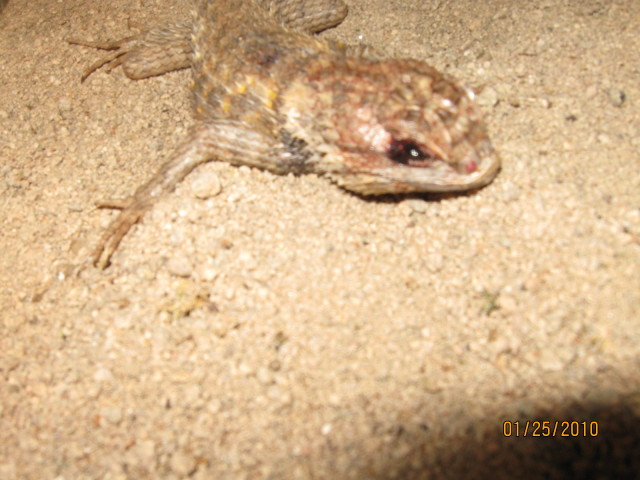 desert spiny lizzard
QuestionEYE
QUESTION: back in June my sister fou
desert spiny lizzard
QuestionEYE
QUESTION: back in June my sister fou
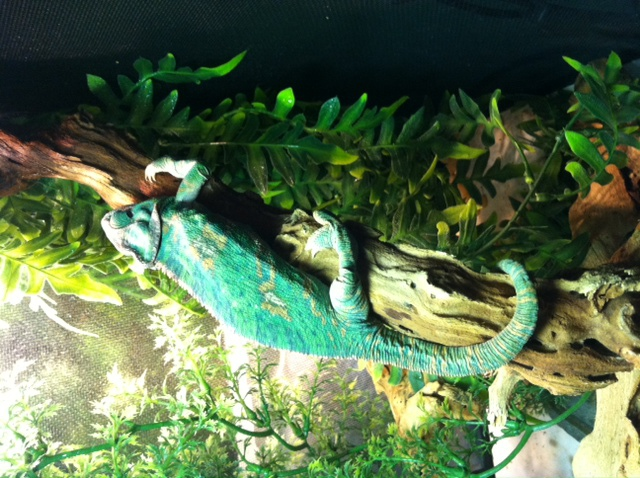 1 year old female veiled chameleon
QuestionLizzy
Lizzys Setup
QUESTION: I ha
1 year old female veiled chameleon
QuestionLizzy
Lizzys Setup
QUESTION: I ha
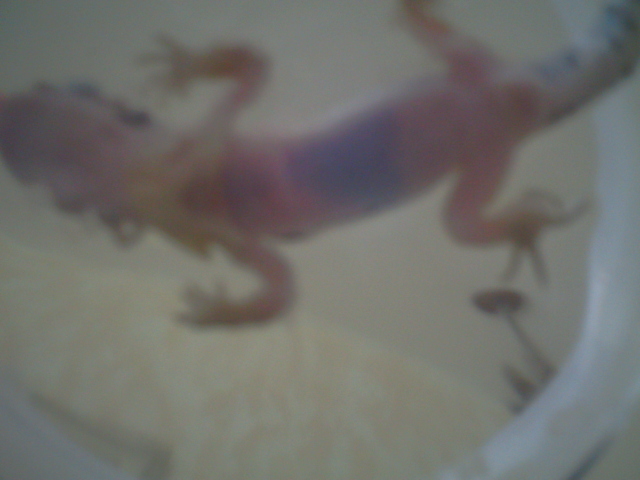 REPTILE IMPACTION !!!!!!!!!!!!!!!!!!!!
QuestionIs that impaction?
QUESTION: My leopard
REPTILE IMPACTION !!!!!!!!!!!!!!!!!!!!
QuestionIs that impaction?
QUESTION: My leopard
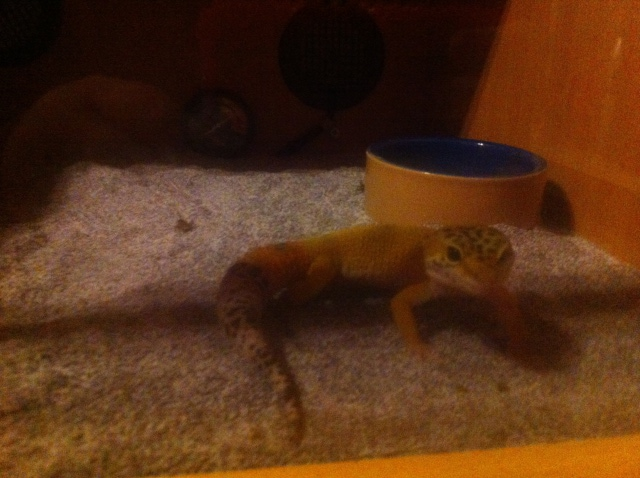 Eating habits in my leopard gecko
Question
Taken a few moths ago
Ive had my gecko
Eating habits in my leopard gecko
Question
Taken a few moths ago
Ive had my gecko
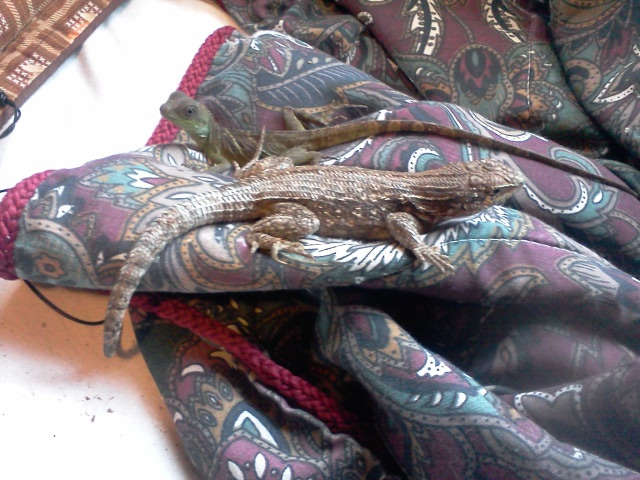 lizards concernings
Questionchinese water dragon&
agama lizard
lizards concernings
Questionchinese water dragon&
agama lizard